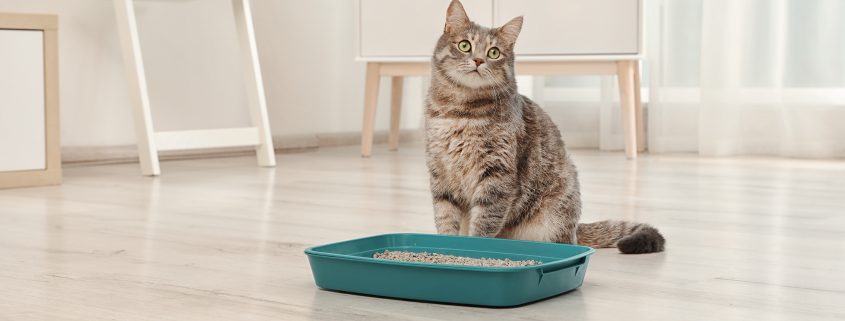When you first get a kitten or cat, a stop at the pet store for supplies is a must. Topping the supply list will be the litter box and kitty litter, but few people give much deep thought to the box itself. Looking at them, you might think that one box is about the same as any other; however, not all litter boxes are created equal. The size, depth, and even shape and privacy level of the litter box are all important to your new furry friend, though what’s most important is cleanliness and maintenance.
Poor litter box maintenance is often to blame for a cat peeing or pooping outside the box. Cats hate dirty litter boxes. If you think your home’s litter box smells bad, imagine how your cat must feel. Their little noses are 14 times more sensitive than a human’s, and they must get inside the box to use it! Keeping a clean bathroom area for your cat also goes a long way toward preventing common health issues, such as urinary tract infections, ammonia-related respiratory irritation, and other sicknesses from the spread of bacteria around your home. To help encourage good litter box habits, here’s what you need to know about keeping your cat’s litter box clean.
How Many Litter Boxes You Should Have?
Just one cat in your household? You should buy two litter boxes. Everybody likes to have options, and your cat should have choices when it comes to where he relieves himself. The general rule of thumb is to have one more litter box than the number of cats you have — it’s called the “C+1 rule.” For example, 1 cat = 2 litter boxes, 2 cats = 3 litter boxes, 3 cats = 4 litter boxes, and so on.
What Type of Cat Litter Should You Buy?
It’s no secret that cats are finicky creatures. If your cat begins to reject the litter boxes, consider that they may not enjoy the texture or scent of the litter you’re buying. Figuring out the type of cat litter your cat prefers can help to ease your cat’s stress around using the boxes and prevent accidents outside the litter boxes. In general, most cats prefer fine-textured, unscented clumping litter, which is good for you because clumping litter is easier to scoop, provides good odor control, and doesn’t need to be fully changed as often as non-clumping litter. That said, not every cat likes this type of litter so you may have to experiment a bit. If you’re feeling adventurous, set out several boxes with different types of litter to see if your cat has a strong preference.
Setting Up the Litter Boxes
- Select and Place the Boxes – Make sure the boxes are large enough that your cat can move around in them comfortably, with no overhang. The boxes should be placed somewhere secluded for maximum privacy, away from day-to-day foot traffic and noisy appliances.
- Line the Litter Boxes – The use of litter box liners is optional, but they are convenient for tidy disposal of the used litter when it is time to empty and deep clean the boxes.
- Pour in the Cat Litter – Most cat litter manufacturers recommend using two to three inches of litter per box. You may want to use three to four inches if your cats are deep scratchers who will dig to the bottom of the box. Start with two inches and experiment until you find the ideal depth for your cat’s preferences.
Have a Scooping Schedule
Maintain your cat’s litter boxes by scooping them daily, and deep cleaning weekly. That seems like a basic task, but even the tidiest of pet parents have trouble sticking to a schedule at first.
Using a litter scoop with small and closely set holes, clean the clumps out of the litter at least once daily—and more often if you have two or more cats. To keep the odor to a minimum after cleaning, add clean litter to replace what you removed. You can also sprinkle a small amount of baking soda into the cat litter before using the litter scoop to mix it throughout the box.
The importance of keeping a clean litter box cannot be understated. Not only is it important for your pet’s health, but also for your own. Humans can contract toxoplasmosis from cat feces. In many cases, you would not be able to tell you were infected until you started displaying flu-like symptoms.
Deep Cleaning and Disposal
It’s best to bring your litter boxes outside when it’s time for a deep clean. You don’t want to be washing them in the tub or the kitchen sink and risk bacteria getting into food prep or bathing areas. To deep clean your kitty’s litter boxes, use a hot water and dish soap mixture to scrub the inside of the box well. Once all the gunk and buildup is removed, rinse the box thoroughly and either towel dry or allow it to dry in the sun. Be sure to have a dedicated scrubber and towels that you only use on the litter boxes.
What should you do with the old litter? Because of the odor, it’s best to place it in a sealed bag and immediately place it in an outdoor trash receptacle. NEVER dispose of kitty litter down drains or toilets, unless you’re prepared for a hefty plumbing bill.
It’s true that everyone loves treating their feline friends to cute cat toys, tasty treats, and unlimited cuddles, but the not-so-cute side of pet ownership can be the dreadful task of cleaning the litter box. Just remember that by making a daily habit of scooping away waste and giving the litter boxes a good scrub once a week, you will have a cat that is much happier and healthier!
Your Pets are our Priority!
At the National Animal Supplement Council (NASC), our number one priority is to promote the health and wellbeing of your pets. That is why we created the NASC Audit Program and the Quality Seal, which helps you identify animal health and nutritional supplements that come from responsible suppliers committed to producing the highest quality, most consistent products available. Visit our website to learn more and to see a list of NASC members that have earned the Quality Seal.


